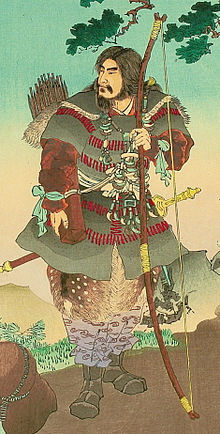Jimmu
| Jimmu | |
|---|---|
 |
|
| Emperor of Japan | |
| Reign | February 11, 660 BCE – April 9, 585 BCE (mythic) |
| Successor | Suizei |
| Born | February 13, 711 BCE (mythic) |
| Died | April 9, 585 BCE (aged 126) (mythic) Japan |
| Burial | Unebi-yama no ushitora no sumi no misasagi (畝傍山東北陵?) (Kashihara, Nara) (mythic) |
| Spouse |
|
| Issue | |
| Father | Ugayafukiaezu |
| Mother | Tamayori-hime |
| Emperor Jimmu | |||||
| Japanese name | |||||
|---|---|---|---|---|---|
| Kanji | 神武天皇 | ||||
|
|||||
| Transcriptions | |
|---|---|
| Romanization | Jinmu-tennō |
Emperor Jimmu (神武天皇 Jinmu-tennō?), (original birth name of Shinto: Kamu-Yamato-Iware-Biko no Mikoto (神倭伊波礼琵古命/神日本磐余彦尊? ), was the first Emperor of Japan, according to legend. His accession is traditionally dated as 660 BCE. According to Japanese mythology, he is a descendant of the sun goddess Amaterasu, through her grandson Ninigi, as well as a descendant of the storm god Susanoo. He launched a military expedition from Hyuga near the Inland Sea, captured Yamato, and established this as his center of power. In modern Japan, Jimmu's accession is marked as National Foundation Day on February 11.
Jimmu is recorded as Japan's first ruler in two early chronicles, Kojiki (712) and Nihon Shoki (721).Nihon Shoki gives the dates of his reign as 660–585 BC. In the reign of Emperor Kanmu (737–806), the eighth-century scholar Ōmi no Mifune designated rulers before Ōjin as tennō (天皇?, "heavenly sovereign"), a Japanese pendant to the Chinese imperial title Tiān-dì (天帝), and gave several of them including Jimmu their canonical names. Prior to this time, these rulers had been known as sumera no mikoto/ōkimi. This practice had begun under Empress Suiko, and took root after the Taika Reforms with the ascendancy of the Nakatomi clan.
...
Wikipedia
